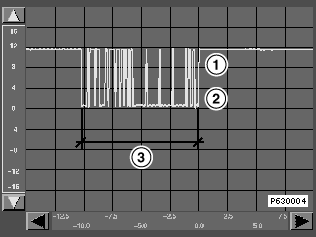
Test preconditions: Always check that the diagnosis cable and tester are OK before working through the test module. If necessary, the diagnosis procedure should be carried out on another vehicle or the diagnosis cable checked by means of a self-test. The ”self test - diagnosis cable” (selection: administration) checks whether the diagnosis cable and the diagnosis interface in the tester are OK. For this purpose, the diagnosis cable must be connected to the test socket at the rear of the tester.
Test procedure: The bus systems (I/K and D-bus) are tested in the test module. The following control units are addressed as part of this test: DME/DDE, ABS/ASC/DSC, KOMBI (instrument cluster), IHKA/IHKR/IHR, ZKE, RADIO, BM/MID and LCM/LSZ. The identification of the control units is read out for testing purposes.
If the identification data is transferred without any problemsthis indicates that the bus function is OK. If several control units are not recognised, this indicates that the bus link (connector, lines) or the voltage supply is disconnected. Control unit failure and a control unit not fitted both indicate the same fault symptom. The control units checked in the test module are assessed at the end of each test step.
If it is not possible to set up a connection with the vehicle the cause is attributed to an interruption in the data transfer on the D-bus. In this case, carry out troubleshooting on the D-bus line.
Faults can constitute shorts to ground and positive as well as line breaks. In this case, it is not possible to transmit data between the control units. This also applies to the I/K-bus when no control unit was recognised in the test module and no control unit could be identified in the quick test. In these cases, troubleshooting should be carried out on the bus line.
A momentary recording of the bus voltage is shown in the following figure. This bus voltage is an example and shows the principle progression of a bus telegram.

1 Bus voltage High
2 Bus voltage Low
3 Telegram length
The fault symptoms have the following characteristics :
Causes may be:
Use the oscilloscope display and the line test in the preset measurements for the purpose of troubleshooting on the bus line.
Disruptive control units in bus system
The causes of these faults may be software-related.
One effect of software errors is that the telegrams are disturbed so that functions are not carried out and malfunctions occur.
Notes for determining disruptive control unit in bus system: